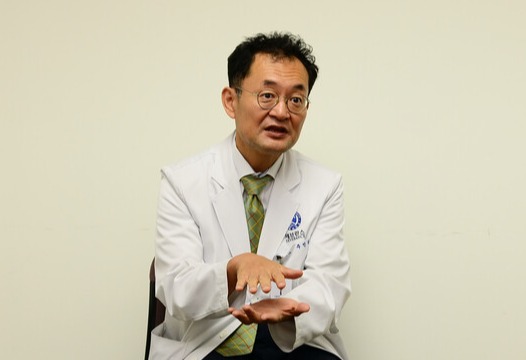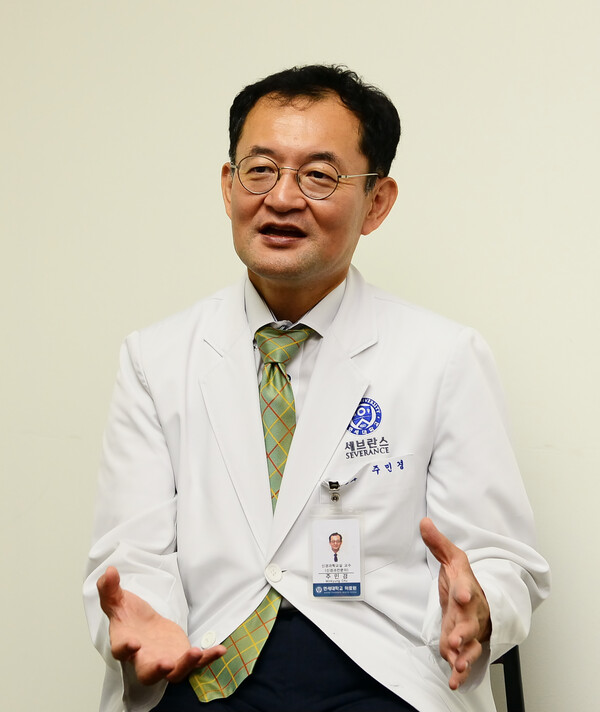"In the first year of the medical residency, I used to get about seven hours of sleep a week. In the second year, I could binge sleep on weekends. However, binge sleep is also a migraine trigger. One day, I went out on a blind date but was hit by a migraine. I couldn't even talk to her properly because of the headache. So, I had to turn around, saying, 'Sorry, I'm having a migraine.’”
Dr. Chu Min-kyung, a migraine patient and a professor of neurology at Severance Hospital who treats other migraine patients, said so, recalling his college days.
Professor Chu said he first experienced migraines, including nausea and a pounding headache when he was a seventh grader after his voice broke. Since then, he has had migraines when he was stressed or when he was not. It wasn't until his sophomore year at the college, when he took a medical class that he realized that migraines caused the symptoms he experienced.
It might be because Professor Chu was a migraine patient himself, but he became interested in headaches after completing his neurology residency in 2002. In 2009, he went to the Montefiore Headache Center at Albert Einstein College of Medicine for a year. When he returned, there was little social interest in migraines. Still, they have become a hot topic, according to Professor Chu, who also serves as the president of the Korean Headache Society.
As a migraine patient, Chu said he understands patients' minds more than anyone else and wants to change their lives. Korea Biomedical Review met him to learn about the migraine treatment environment in Korea.

Question: How do you define migraine?
Answer: When Koreans talk about migraines (pyeondutong in Korean), they reveal a fixed idea of a "one-sided headache" because the Chinese character for “pyeon” means “lopsided.” However, a migraine is diagnosed when a person has a recurring, severe headache that is accompanied by nausea. The pain usually lasts between four and 72 hours, with some migraines lasting less than four hours – probable migraine. About 3 percent of women and 0.5 percent of men have headaches, but they are often tolerated depending on the severity of the pain.
Q: Why are migraines more common in women than in men?
A: Hormones are the reason. Migraines are very much related to hormones. This is why they are most common in women and men during puberty when hormonal changes occur. I remember having my first migraine in the first year of middle school, a month after the onset of puberty. However, the incidence of migraine tends to rise slowly in men, whereas, in women, the incidence tends to rise sharply and persist and then drop sharply at menopause.
So, if you look at the distribution of migraine sufferers, about 80 percent of them are women in their mid-40s, and most of them get better about two years after menopause. Therefore, I consider migraine to be a female neurology. Migraine medications are not meant to cure migraines but to buy time until they go away. Since it’s not easy to change your lifestyle, the best thing you can do is to treat the symptoms and minimize the pain with preventive treatments until you’re in your 50s, when hormonal influences are lessened.
Q: How do you recognize a migraine when there are many different causes of headaches?
A: It depends on your medical history and symptoms. Headaches can be categorized into primary and secondary headaches. Primary headaches, such as migraines, cluster headaches, and tension-type headaches, account for 98 percent of headaches.
In addition, migraine is diagnosed when a person has at least two of the following four headache symptoms: five or more headaches lasting between four and 72 hours, pulsating or throbbing pain on one side of the head, moderate to severe pain with a heartbeat, and moderate to severe intensity.
In addition, migraines are often accompanied by comorbidities, including nausea, vomiting, and light and sound phobia, which is an aversion to bright lights and loud sounds when you have a headache.
Secondary headache is a headache caused by other causes. It is a dangerous (lightning) headache that can be life-threatening and requires accurate diagnosis.
Typically, these include severe headaches that start suddenly within 1-2 minutes, new headaches after age 50, headaches that occur when exercising, headaches that are different from before, headaches with neurological symptoms, headaches that get better or worse when lying down or standing up (orthostatic headache), and headaches that occur in people with immunocompromised immune systems.
Sometimes, people come to the hospital with severe headaches and want to take a picture, but most of them have primary headaches, and there is nothing wrong with them.

Q: How do you treat migraines?
A: Because migraines can be caused by lifestyle, environmental, and genetic factors, both medication and non-medication treatments are available. However, migraines are treated with medication first. There are two main types of medication -- acute and preventive. Acute treatment is used to relieve the pain after a migraine has occurred with over-the-counter painkillers, like acetaminophen, or, if the symptoms are severe, triptan.
Prophylactic treatment relieves pain and prevents future migraines. Various oral prophylactic drugs, such as antidepressants, beta-blockers, and calcium channel blockers, are available. The treatment environment has improved considerably in recent years with targeted therapies, including CGRP (calcitonin gene-related peptide) inhibitors like Emgality (galcanezumab). CGRP inhibitors are migraine-specific drugs that directly inhibit the binding of CGRP to its receptors, a key factor in triggering migraines.
However, many problems can arise over time. People can develop skin reactions and antibodies against CGRP inhibitors, making them less effective. In particular, you can’t get pregnant for six months after taking CGRP inhibitors. This is because they have yet to secure safety regarding fertility. Therefore, many women of childbearing age cannot take CGRP inhibitors because of pregnancy.
Lifestyle modifications are also necessary. Obesity is a migraine trigger, so weight control is essential. I used to weigh almost 100 kilograms, but now I'm at a normal weight. That's why I have a treadmill in my office. Exercising consistently for 30 to 60 minutes at least three to four days a week can prevent migraines.
Q: As recently as the early 90s, there was no good treatment for migraines. Nowadays, the treatment environment seems to have improved considerably.
A: The migraine drug triptan came out in the early 2000s, and preventive treatments were introduced in 2005-2006. Botox treatment was introduced in 2011-2012, and CGRP inhibitors were introduced in 2019, making a big progress in this area.
Last year, the first oral CGRP inhibitor, AbbVie’s Aquipta (atogepant), was approved in Korea, and this year, a treatment that can be used for both acute and preventive treatment will be introduced.
AstraZeneca’s Zomig (zolmitriptan), a stray-type treatment, is also expected to be available. Many migraine sufferers experience nausea and vomiting, which can be prevented by spraying it into the nose.
There are other triptans alone, but NSAID-containing composite drugs are most effective for treating migraines that slowly build in intensity. An antiemetic that can improve absorption may work better with triptans. The latter will also be available this year.
Q: However, some point out that there are stumbling blocks to treatments used.
A: CGRP inhibitors Emgality and Ajovi (fremanezumab) are limited to prevention for chronic migraine patients 18 years and older who meet the International Classification of Headache Disorders (ICHD-3) diagnostic criteria. CGRP inhibitors are not indicated for patients with migraine onset in adolescence.
In addition, the duration of treatment is limited to a maximum of 12 months, and cross-administration with CGRP inhibitors is not allowed. The reimbursement criteria may have been based on the initial U.K. guidelines, but even an appeal to the Health Insurance Review and Assessment Service (HIRA) has been unsuccessful.
Emgality and Ajovy are available for patients with a history of migraine for at least one year and at least 15 headache days per month for at least six months before treatment, at least eight of which are migraine-type headaches, and a Migraine Disability Inventory Disability Scale (MIDAS) score of 21 or higher (migraine headaches for 21 or more days in three months interfere with daily activities) or a Headache Impact Test (HIT-6) score of 60 or higher (a 36- to 78-point scale assessing the impact of headaches on life, with a score of 60 or higher classified as severe headache impact), and patients who have had treatment failure with three or more migraine preventive medications within the past year and have not achieved a 50 percent or greater reduction in monthly migraine days after at least eight weeks of treatment with the maximum tolerated dose of each medication, or who cannot use other migraine preventive medications due to side effects or contraindications.
This is not the end of the story. Patients must keep their “medication diaries” to verify the duration of CGRP inhibitors. The hospital manages the patient's headache diary. It must submit objective data on the patient at the first dose and objective data on response assessment every three months for continued treatment (medication history, medical records, and headache diary).
Also, if you switch from something like Ajovy to Emgality and it's half as effective, you have to switch to another drug. However, as cross-over is not allowed, you have to take three or more migraine medications within a year, each at the maximum tolerated dose for eight weeks, to get reimbursed.
This is to prove that the three medications are ineffective, so the patient has to start over (treatment) for six months before they can be prescribed a covered medication. They are forced to take a drug that has failed, even though it works. Some say that because of these stringent criteria, the Ministry of Food and Safety has only been able to spend 3 percent of the health insurance funds it originally estimated for migraine treatment. Ultimately, despite being covered by insurance, most patients pay for their medications out of pocket or are uninsured.
Related articles
- Korean neurologists express high expectations for AbbVie's migraine drug Aquipta
- Nu Eyne to present migraine electroceutical at Bio Korea 2024
- AbbVie's Aquipta effective in preventing migraine in patients who failed oral therapy
- If you have 8 or more migraines a month, suspect chronic headaches
- AZ’s migraine drug Zomig in short supply due to hoarding
- McKinsey highlights closing women’s health gaps amid workforce challenges, health crises
- Korean headache society pushes for CGRP as 1st-line migraine treatment
- Aquipta hailed as game-changer in migraine prevention at AbbVie symposium

